 Pyramids are linked to Egypt in people’s minds, but they’ve been constructed by ancient civilizations on various parts of our planet. The Mesopotamians were the first civilization to build structures that had a pyramid-like design, the ziggurats. Sumerians, Babylonians, Elamites, Akkadians, and Assyrians–they were all keen on building ziggurats as part of larger temple complexes, serving religious purposes. Made of sun-dried mud-bricks, the ziggurats of Mesopotamia were gold-bronze painted marvels, but little remains of them now.
Pyramids are linked to Egypt in people’s minds, but they’ve been constructed by ancient civilizations on various parts of our planet. The Mesopotamians were the first civilization to build structures that had a pyramid-like design, the ziggurats. Sumerians, Babylonians, Elamites, Akkadians, and Assyrians–they were all keen on building ziggurats as part of larger temple complexes, serving religious purposes. Made of sun-dried mud-bricks, the ziggurats of Mesopotamia were gold-bronze painted marvels, but little remains of them now.
In Mexico, there is the magnificent Pyramid of the Sun and the Pyramid of Moon, but also what would be the world’s largest pyramid if measuring by volume, the Great Pyramid of Cholula. Built in the Mexican state of Puebla, the Pyramid of Cholula rises some 180 feet above the surrounding plain and is 1,300 by 1,300 feet at the base.
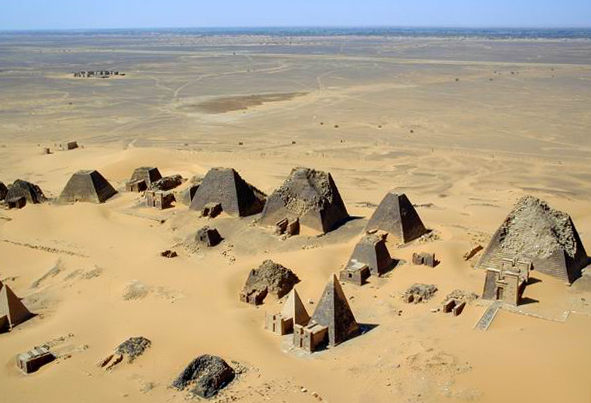
Aerial view of the Nubian pyramids at Meroe, Photo by B N Chagny, CC BY-SA 1.0
The Kushite kingdoms thrived during antiquity, the first of which had its capital at Kerma between 2600 and 1520 BC, the second of which centered on Napata in between 300 and 100 BC, and the last of which was based around Meroë in-between 300 BC and 300 AD.
While Kerma is recognized as Nubia’s first centralized state, having its own architecture and burial customs, the two latter kingdoms Napata and Meroë were under the influence of Egypt, hence the emergence of the pyramids here. The Kushite kingdoms undoubtedly competed strongly with Egypt, particularly in terms of economics and military forces, but also in culture and politics.
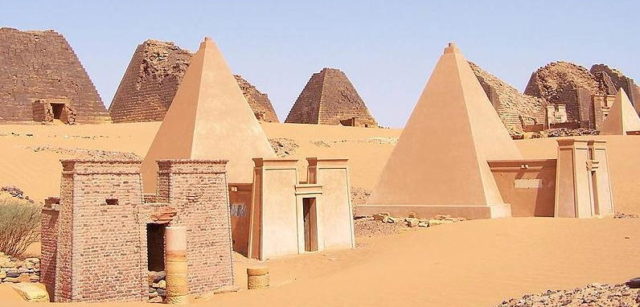
Wide view of Nubian pyramids, Meroe. Three of these pyramids are reconstructed.
The pyramids that were built in Nubia filled the same purpose as those in Egypt, the eternal resting places of the numerous kings and queens that reigned over Napata and Meroë. We might not be certain whether these two latter Kushite kingdoms were conscious rivals over who could build more pyramids, but the numbers speak for themselves. The 255 pyramids found today in Sudan are nearly twice the number scattered across the Egypt. According to various accounts, in Egypt the number of the pyramids totals between 118 and 138.
Which brings us back to 751 BC, when the Kushite king, Piankhi, overthrew the 24th Dynasty and united the entire Nile valley, all the way from the delta to the city of Napata, during his reign. Piankhi, as well as his descendants, ruled as the pharaohs of the 25th Dynasty. The Napatan domination of Egypt would last until the Assyrian conquest of Egypt in 656 BC.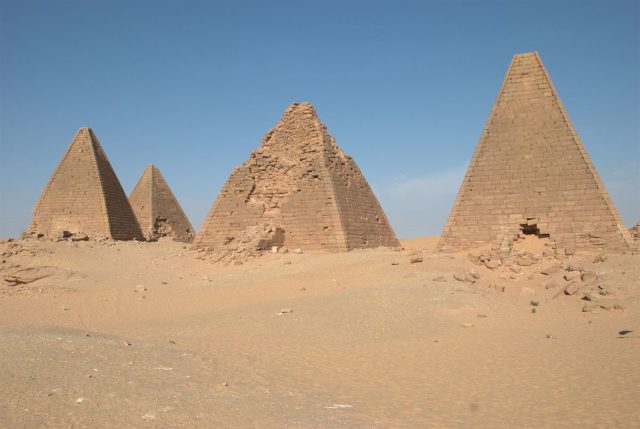
Pyramids west of Jebel Barkal, Sudan. North group. Photo by Bertramz, CC BY 3.0
The first of those estimated 255 pyramids was erected at the site of El-Kurru, which holds the tombs of King Kashta and his son Piye (Piankhi). Their successors, Shabaka, Shabataka, and Tanwetamani, were also buried there. Moreover, 14 other pyramids were built at the site dedicated to their queens, and a few are designated as notable warrior queens.
Later Napatan pyramids were found on the west bank of the Nile in Upper Nubia, at the site of Nuri. This necropolis site was the burial ground of some 21 kings and 52 queens and princes. Their bodies were prepared and situated in huge granite sarcophagi, and two of the most notable names to rest there were Analmi and Aspelta. The pyramid belonging to Taharqa is deemed the oldest and largest pyramid at Nuri, also serving as the eternal resting place of this great Napatan king and 25th Dynasty pharaoh.
If you want to see the most extensive of all Nubian pyramids, it can be found in Meroë. Located between the fifth and sixth cataracts of the Nile, roughly 62 miles north of Khartoum, it is currently the largest and the capital city of Sudan. During the Meroitic period, the remains of over 40 queens and kings were consigned to Meroë.
While Egypt had needed some three millennia to build its roughly 120 pyramids, the Nubian pyramids of Sudan had been built in the time span of just a few centuries. Compared to the Egyptian ones, Nubian pyramids differ considerably. They are built of stepped courses of horizontally situated stone blocks and their height ranges from approximately 20 to 98 feet.
Furthermore, the edifices rise from fairly small foundation footprints that rarely extend over 26 feet in width, which gives them their trademark of being tall and narrow structures, inclined at approximately 70 degrees. They are striking, to say the least.
The majority of Nubian pyramids have temple structures adjoining their base, which reveal some genuine Kushite characteristics. Egyptian pyramids that bear similar height have foundation footprints typically at least five times larger, plus their inclination reaches angles between 40 and 50 degrees.
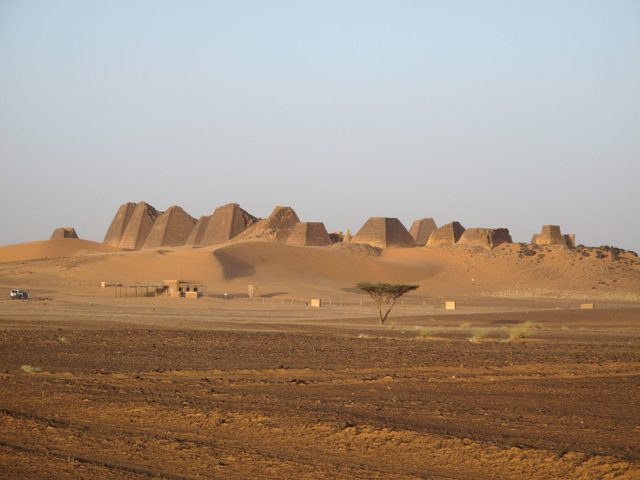
The Pyramids of Meroë in Sudan, seen from the distance, Photo by Ron Van Oers, CC BY-SA 3.0-igo
The royal occupants of the Nubian pyramids were all well preserved in tomb chapels and most likely adorned with jewelry, laid to rest in wooden mummy cases. Unfortunately, evidence suggests that these ancient tombs have been extensively robbed since ancient times.
By the time they were found and thoroughly explored by archaeologists during the 19th and 20th centuries, the Nubian pyramids contained many items but no jewelry. They found wooden boxes, remains of bows and quivers of arrows, archers’ thumb rings, and horse harnesses. Moreover, they discovered pieces of furniture, some pottery and colored glass, metal vessels, and other artifacts that point to a vivid Merotic trade that ran its course in the Hellenistic world and these north Africa civilizations.
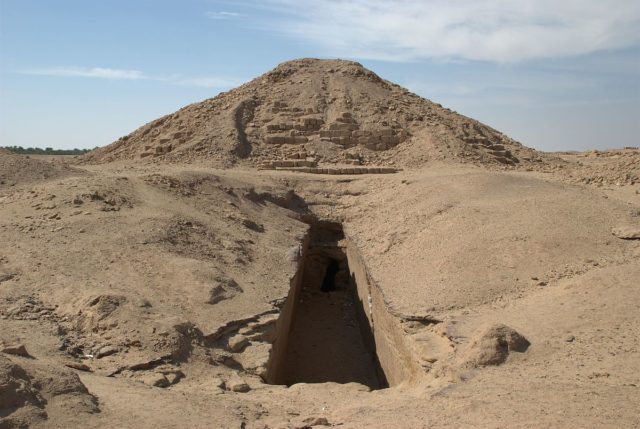
Pyramid K.1. of the 4th century BC at El-Kurru, south of Jebel Barkal, North Sudan, Photo by Bertramz, CC BY 3.0
When one pyramid found at Meroë was excavated, they found 390 stones and hundreds of heavy items adorned with rock art. Also discovered was an entirely buried cow, as were ringing rocks probably used to produce some melodic ancient tune.
The Nubian pyramids were damaged during the 1830s. Giuseppe Ferlini, an Italian doctor who changed his occupation to explorer and treasure hunter, blew the tops off roughly 40 tombs while looking for treasures.
Today the Nubian pyramids bear a protected status and are recognized as a UNESCO World Heritage Site.


No comments:
Post a Comment